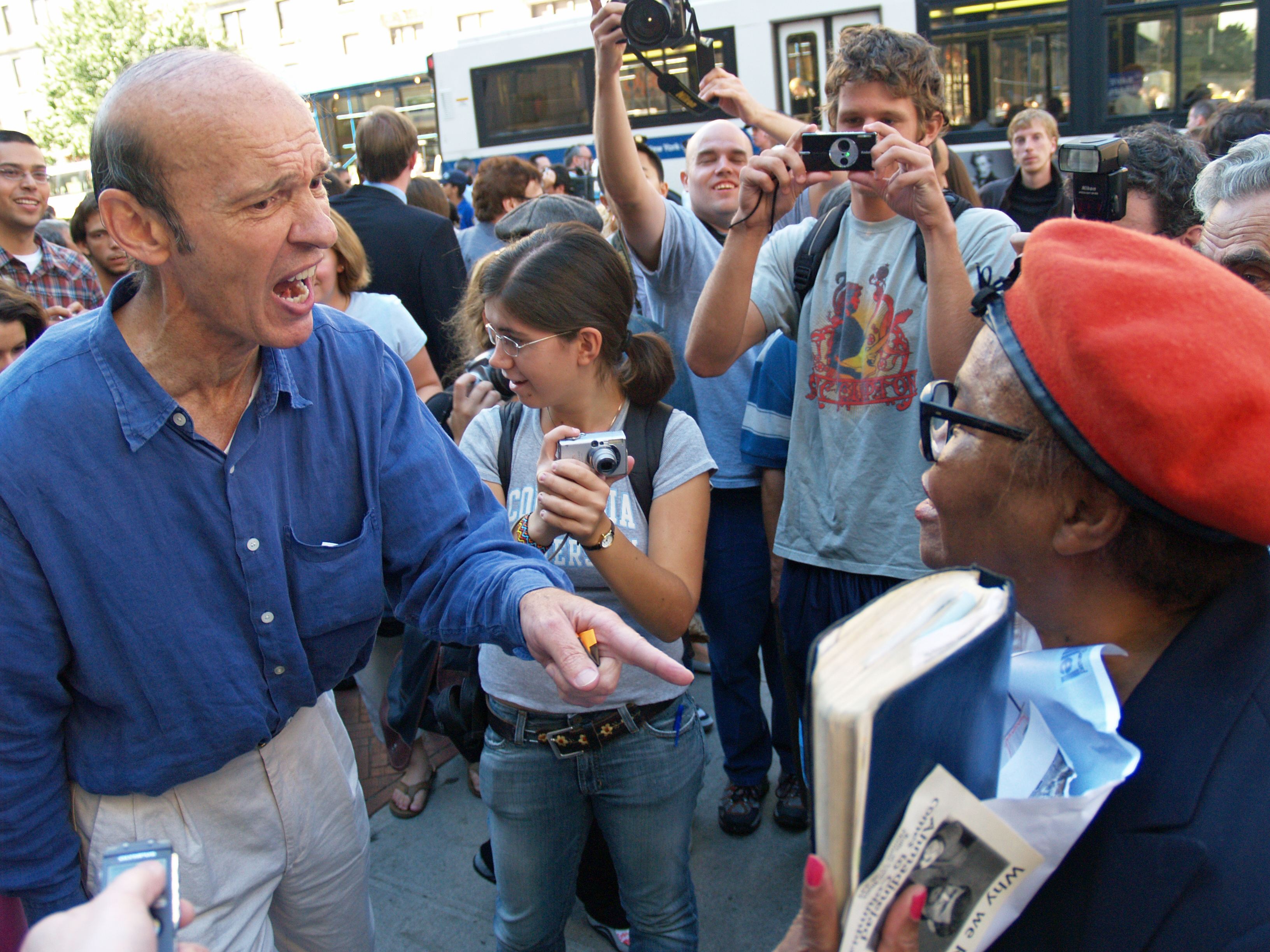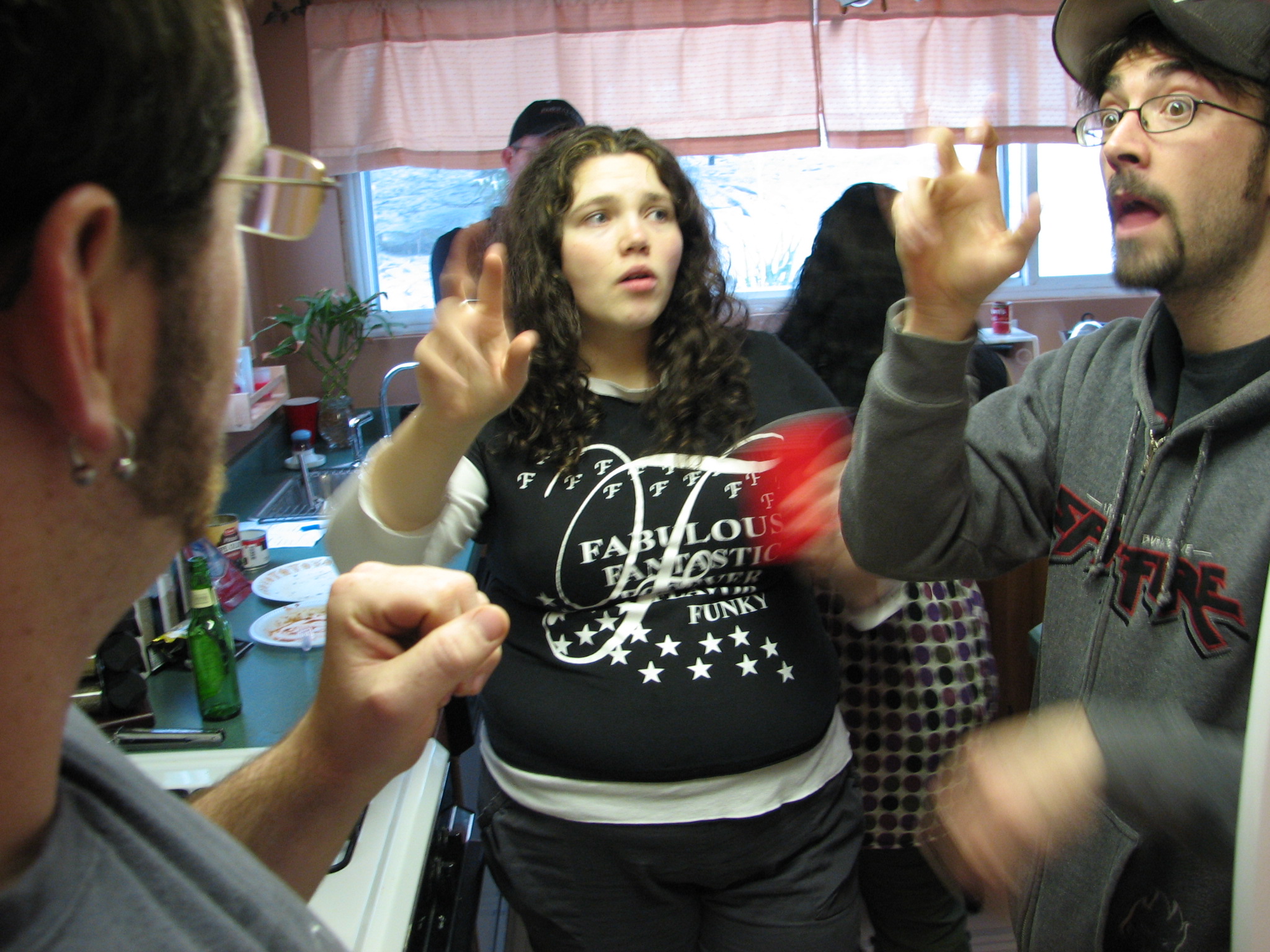|
Pointing
Pointing is a gesture specifying a direction from a person's body, usually indicating a location, person, event, thing or idea. It typically is formed by extending the arm, hand, and index finger, although it may be functionally similar to other hand gestures. Types of pointing may be subdivided according to the intention of the person, as well as by the linguistic function it serves. Pointing typically develops within the first two years of life in humans, and plays an important role in language development and reading in children. It is central to the use of sign language, with a large number of signs being some variation on pointing. The nature of pointing may differ for children who have autism or who are deaf, and may also vary by gender. It is typically not observed in children who are blind from birth. Pointing may vary substantially across cultures, with some having many distinct types of pointing, both with regard to the physical gestures employed and their interpret ... [...More Info...] [...Related Items...] OR: [Wikipedia] [Google] [Baidu] |
Index Finger
The index finger (also referred to as forefinger, first finger, second finger, pointer finger, trigger finger, digitus secundus, digitus II, and many other terms) is the second digit of a human hand. It is located between the thumb and the middle finger. It is usually the most dextrous and sensitive digit of the hand, though not the longest. It is shorter than the middle finger, and may be shorter or longer than the ring finger (see digit ratio). Anatomy " Index finger" literally means "pointing finger", from the same Latin source as '' indicate;'' its anatomical names are "index finger" and "second digit". The index finger has three phalanges. It does not contain any muscles, but is controlled by muscles in the hand by attachments of tendons to the bones. Uses A lone index finger held vertically is often used to represent the number 1 (but finger counting differs across cultures), or when held up or moved side to side (finger-wagging), it can be an admonitory ge ... [...More Info...] [...Related Items...] OR: [Wikipedia] [Google] [Baidu] |
Gesture
A gesture is a form of nonverbal communication or non-vocal communication in which visible bodily actions communicate particular messages, either in place of, or in conjunction with, speech. Gestures include movement of the hands, face, or other parts of the Human body, body. Gestures differ from physical non-verbal communication that does not communicate specific messages, such as purely Emotional expression, expressive displays, proxemics, or displays of joint attention.Kendon, Adam. (2024) ''Gesture: Visible Action as Utterance''. Cambridge: Cambridge University Press. Gestures allow individuals to communicate a variety of feelings and thoughts, from contempt and hostility to approval and affection, often together with body language in addition to words when they speak. Gesticulation and speech work independently of each other, but join to provide emphasis and meaning. Gesture processing takes place in areas of the brain such as Broca's area, Broca's and Wernicke's areas, wh ... [...More Info...] [...Related Items...] OR: [Wikipedia] [Google] [Baidu] |
Language Acquisition By Deaf Children
Language acquisition is a natural process in which infants and children develop proficiency in the first language or languages that they are exposed to. The process of language acquisition is varied among deaf children. Deaf children born to deaf parents are typically exposed to a sign language at birth and their language acquisition follows a typical developmental timeline. However, at least 90% of deaf children are born to hearing parents who use a spoken language at home. Hearing loss prevents many deaf children from hearing spoken language to the degree necessary for language acquisition. For many deaf children, language acquisition is delayed until the time that they are exposed to a sign language or until they begin using amplification devices such as hearing aids or cochlear implants. Deaf children who experience delayed language acquisition, sometimes called language deprivation, are at risk for lower language and cognitive outcomes. However, profoundly deaf children who re ... [...More Info...] [...Related Items...] OR: [Wikipedia] [Google] [Baidu] |
Sign Language
Sign languages (also known as signed languages) are languages that use the visual-manual modality to convey meaning, instead of spoken words. Sign languages are expressed through manual articulation in combination with #Non-manual elements, non-manual markers. Sign languages are full-fledged natural languages with their own grammar and lexicon. Sign languages are not universal and are usually not mutual intelligibility, mutually intelligible, although there are similarities among different sign languages. Linguists consider both spoken and signed communication to be types of natural language, meaning that both emerged through an abstract, protracted aging process and evolved over time without meticulous planning. This is supported by the fact that there is substantial overlap between the neural substrates of sign and spoken language processing, despite the obvious differences in modality. Sign language should not be confused with body language, a type of non verbal communicati ... [...More Info...] [...Related Items...] OR: [Wikipedia] [Google] [Baidu] |
Deixis
In linguistics, deixis () is the use of words or phrases to refer to a particular time (e.g. ''then''), place (e.g. ''here''), or person (e.g. ''you'') relative to the Context (language use), context of the utterance. Deixis exists in all known natural languagesLyons, John (1977) "Deixis, space and time" in ''Semantics'', Vol. 2, pp. 636–724. Cambridge University Press. and is closely related to Anaphora (linguistics), anaphora, with a sometimes unclear distinction between the two. In linguistic anthropology, deixis is seen as the same as, or a subclass of, indexicality. The term's origin is . To this, Chrysippus () added the specialized meaning ''point of reference'', which is the sense in which the term is used in contemporary linguistics. Types There are three main types of deictic words, as described by Charles J. Fillmore: personal, spatial, and temporal.Fillmore, Charles J (1971) ''Lectures on Deixis''. CSLI Publications (reprinted 1997). In some languages, these may ove ... [...More Info...] [...Related Items...] OR: [Wikipedia] [Google] [Baidu] |
Reading (process)
Reading is the process of taking in the sense or meaning of symbols, often specifically those of a written language, by means of Visual perception, sight or Somatosensory system, touch. For educators and researchers, reading is a multifaceted process involving such areas as word recognition, orthography (spelling), Alphabetic principle, alphabetics, phonics, phonemic awareness, vocabulary, comprehension, fluency, and motivation. Other types of reading and writing, such as pictograms (e.g., a hazard symbol and an emoji), are not based on speech-based writing systems. The common link is the interpretation of symbols to extract the meaning from the visual notations or tactile signals (as in the case of braille). Overview Reading is generally an individual activity, done silently, although on occasion a person reads out loud for other listeners; or reads aloud for one's own use, for better comprehension. Before the reintroduction of Palaeography, separated text (spaces betwe ... [...More Info...] [...Related Items...] OR: [Wikipedia] [Google] [Baidu] |
Language Acquisition
Language acquisition is the process by which humans acquire the capacity to perceive and comprehend language. In other words, it is how human beings gain the ability to be aware of language, to understand it, and to produce and use words and sentence (linguistics), sentences to communicate. Language acquisition involves structures, rules, and representation. The capacity to successfully use language requires human beings to acquire a range of tools, including phonology, morphology (linguistics), morphology, syntax, semantics, and an extensive vocabulary. Language can be vocalized as in speech, or manual as in sign language, sign. Human language capacity is language processing in the brain, represented in the brain. Even though human language capacity is finite, one can say and understand an infinite number of sentences, which is based on a syntactic principle called recursion. Evidence suggests that every individual has three recursive Mechanisms of mindfulness meditation, mech ... [...More Info...] [...Related Items...] OR: [Wikipedia] [Google] [Baidu] |
Language Development
Language development in humans is a process which starts early in life. Infants start without knowing a language, yet by 10 months, babies can distinguish speech sounds and engage in babbling. Some research has shown that the earliest learning begins in utero when the fetus starts to recognize the sounds and speech patterns of its mother's voice and differentiate them from other sounds after birth. Typically, children develop receptive language abilities before their verbal or expressive language develops. Receptive language is the internal processing and understanding of language. As receptive language continues to increase, expressive language begins to slowly develop. Usually, productive/expressive language is considered to begin with a stage of pre-verbal communication in which infants use gestures and vocalizations to make their intents known to others. According to a general principle of development, new forms then take over old functions, so that children learn words to e ... [...More Info...] [...Related Items...] OR: [Wikipedia] [Google] [Baidu] |
American Sign Language
American Sign Language (ASL) is a natural language that serves as the predominant sign language of Deaf communities in the United States and most of Anglophone Canadians, Anglophone Canada. ASL is a complete and organized visual language that is expressed by employing both manual and nonmanual features. Besides North America, dialects of ASL and ASL-based creole language, creoles are used in many countries around the world, including much of West Africa and parts of Southeast Asia. ASL is also widely learned as a second language, serving as a lingua franca. ASL is most closely related to French Sign Language (LSF). It has been proposed that ASL is a creole language of LSF, although ASL shows features atypical of creole languages, such as agglutination, agglutinative morphology. ASL originated in the early 19th century in the American School for the Deaf (ASD) in Hartford, Connecticut, from a situation of language contact. Since then, ASL use has been propagated widely by schools ... [...More Info...] [...Related Items...] OR: [Wikipedia] [Google] [Baidu] |
Egocentric
Egocentrism refers to difficulty differentiating between self and other. More specifically, it is difficulty in accurately perceiving and understanding perspectives other than one's own. Egocentrism is found across the life span: in infancy, early childhood, adolescence, and adulthood. Although egocentric behaviors are less prominent in adulthood, the existence of some forms of egocentrism in adulthood indicates that overcoming egocentrism may be a lifelong development that never achieves completion. Adults appear to be less egocentric than children because they are faster to correct from an initially egocentric perspective than children, not because they are less likely to initially adopt an egocentric perspective. Definition Egocentrism is associated with difficulty differentiating between self and other. More specifically, it refers to difficulty accurately assuming or understanding a perspective other than one's own. During infancy When infants and young children begin to s ... [...More Info...] [...Related Items...] OR: [Wikipedia] [Google] [Baidu] |
Hearing Loss
Hearing loss is a partial or total inability to hear. Hearing loss may be present at birth or acquired at any time afterwards. Hearing loss may occur in one or both ears. In children, hearing problems can affect the ability to acquire spoken language, and in adults it can create difficulties with social interaction and at work. Hearing loss can be temporary or permanent. Hearing loss related to age usually affects both ears and is due to cochlear hair cell loss. In some people, particularly older people, hearing loss can result in loneliness. Hearing loss may be caused by a number of factors, including: genetics, ageing, exposure to noise, some infections, birth complications, trauma to the ear, and certain medications or toxins. A common condition that results in hearing loss is chronic ear infections. Certain infections during pregnancy, such as cytomegalovirus, syphilis and rubella, may also cause hearing loss in the child. Hearing loss is diagnosed when hearing ... [...More Info...] [...Related Items...] OR: [Wikipedia] [Google] [Baidu] |









